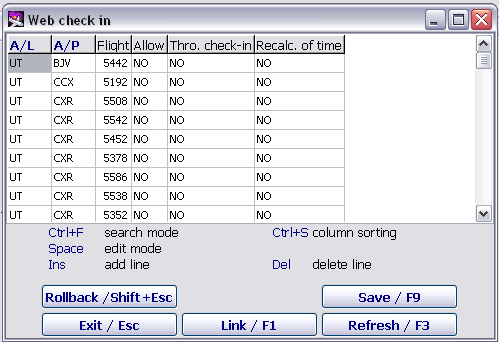Difference between revisions of "Administration module"
Jump to navigation
Jump to search
| Line 40: | Line 40: | ||
Operation schedule additional steps are carried out on the basis of the presented table during planned forming DFP (daily flight plan) on corresponding flights (where web check-in is allowed). | Operation schedule additional steps are carried out on the basis of the presented table during planned forming DFP (daily flight plan) on corresponding flights (where web check-in is allowed). | ||
| + | ==Self check-in kiosks== | ||
| + | To describe self check-in kiosks in DCS Astra, it is required to adjust the following settings: | ||
| + | :1. To specify the Self check-in kiosks AP/AL group in the Terminal group table of the Administration module. | ||
| + | :An AP value presents an airport, where a kiosk is located, АК value presents an airline to which this airport belongs. It is also possible to specify a group name if necessary. | ||
| + | :2. To enter a terminal in the Terminals table. | ||
| + | :For the correct specification of the terminal, it is required to enter: a terminal of АL (an airline code) or AP (an airport code), K (K is the indication of a terminal in Latin) and then a terminal number, for example: UT001K or DMO01K. | ||
| + | :3. To activate the terminal in the Terminal affiliation table. | ||
| + | :4. To enter a user login for the terminal of the self check-in kiosk in the User table. | ||
| + | :5. To assign a role to the user in the Distribution of categories (roles) table. | ||
| + | :6. To restrict access for the user by AL or AP in the Access to airlines and Access to airports tables if necessary. | ||
Revision as of 13:43, 23 August 2021
Flight settings
The "Transfer handling" table
The Transfer handling table is intended for monitoring transfer passenger check-in. The analysis of transfer baggage check-in validity and through check-in by directions are carried out on the basis of the presented table during check-in.
The description of the table columns:
- AL: an airline code (it is entered manually or by using the F1 function key)
- Flight(s) for arrival: flights from which transfer is possible or not are listed separated by a space
- А/p of transfer: an airport of transfer (it is entered manually or by using the F1 function key)
- AL: an airline code (it is entered manually or by using the F1 function key)
- Flight(s) for departure: flights to which transfer is possible or not are listed separated by a space
- Thro. check-in: through check-in procedure
- WL: waiting list
- NOREC: check-in of passengers who are not on the list of through check-in
- Transfer lug.: check-in of transfer luggage
- External transfer onward: check-in of transfer luggage for flights check-in for which is carried out in external systems (different from DCS AMBER)
- Allow:
YES(transfer is allowed) /NO(transfer is prohibited) - Min. connection: minimum time between transfer route connections
- Max. connection: maximum time between transfer route connections.
The "WEB check-in" table
The WEB check-in table is intended for defining flight settings (an airline, an airport) to work with WEB check-in.
The example of the table:
The description of the table columns:
- А/L: an airline code (not mandatory)
- А/P: an airport code (not mandatory)
- Flight: a flight number (not mandatory)
- Allow: an operating mode is defined by using the space key (
YESis allowed,NOis prohibited). - Thro. check-in: an operating mode is defined by using the space key (
YES– through check-in is allowed,NO– through check-in is prohibited). - Recalc. of time: an operating mode is defined by using the space key (
YES– to calculate time of operation schedule depending on entering flight delay,NO– not to calculate time of operation schedule depending on entering flight delay)
Operation schedule additional steps are carried out on the basis of the presented table during planned forming DFP (daily flight plan) on corresponding flights (where web check-in is allowed).
Self check-in kiosks
To describe self check-in kiosks in DCS Astra, it is required to adjust the following settings:
- 1. To specify the Self check-in kiosks AP/AL group in the Terminal group table of the Administration module.
- An AP value presents an airport, where a kiosk is located, АК value presents an airline to which this airport belongs. It is also possible to specify a group name if necessary.
- 2. To enter a terminal in the Terminals table.
- For the correct specification of the terminal, it is required to enter: a terminal of АL (an airline code) or AP (an airport code), K (K is the indication of a terminal in Latin) and then a terminal number, for example: UT001K or DMO01K.
- 3. To activate the terminal in the Terminal affiliation table.
- 4. To enter a user login for the terminal of the self check-in kiosk in the User table.
- 5. To assign a role to the user in the Distribution of categories (roles) table.
- 6. To restrict access for the user by AL or AP in the Access to airlines and Access to airports tables if necessary.
See also:
Other sections:
- Boarding module
- Seasonal Schedule Management Module
- Check-in Preparation Module
- Check-in module
- Documentation module
- Statistics module
- History module
- EMDA Module
- Messages Module
- Access Module
- Baggage Payment Module
- Transportation Module
- Weight and Balance Module
- Web Check-in at a Cost Service
- Alarms Designations
- Self Check-in Kiosk Software

